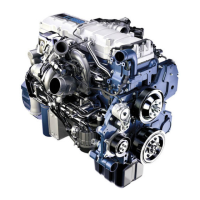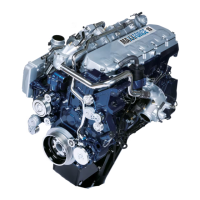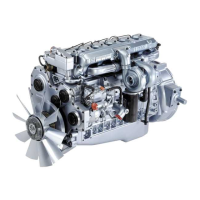36 ENGINE SYSTEMS
NOTE: Early fuel filter assemblies may have an M10
Plug assembly (item 2) in the location of M12 port
fitting (item 9). Item 2 is used by the assembly plants
as a fuel fill.
• If item 2 is installed on housing cover assembly, it
canbeusedtomeasureunfiltered fuel pressure.
• If item 2 is installed in item 9 location, it can be
used to measure fuel inlet restriction.
The low-pressure fuel supply pump draws fuel from
the fuel tank through a 150 micron strainer in the fuel
filter assembly.
An optional electric heating element in the fuel filter
housing warms incoming fuel to prevent waxing.
If water is in the fuel, the filter element repels water
molecules, water collects at the bottom of the element
cavity in the fuel filter housing, and a Water In Fuel
(WIF) sensor in the element cavity detects water
in the fuel. When enough water accumulates in
the element cavity, the WIF sensor sends a signal
to the Electronic Control Module (ECM); the ECM
illuminates the amber WATER IN FUEL lamp on the
instrument panel. A fuel drain valve handle on the
housing can be opened to drain contaminants (usually
water) from the fuel filter housing. Another drain valve
in the bottom of the housing drains strainer cavity.
A built-in fuel regulator valve, calibrated to open at
about 414 - 482 kPa (60 - 70 psi), regulates and
relieves excessive pressure. During idle and light
engine loads, when injector demand is low, most of
the fuel is cycled between the fuel filter housing and
low-pressure fuel pump. When engine demand
increases, engine fuel consumption increases
resulting in less fuel cycling. Under heavy loads
fuel flows through the filter with little or no cycling.
Fuel is conditioned as it flows through a main filter and
central post. The post prevents fuel from draining from
the fuel rail during servicing.
An optional Engine Fuel Pressure (EFP) sensor
detects low pressure caused by high fuel filter
restriction and sends a signal to the ECM; the ECM
illuminates the amber FUEL FILTER lamp on the
instrument panel.
Fuel flows from the fuel filter housing into the fuel rail,
through the fuel rail into six drilled holes (one for each
injector) to each injector.
When the fuel injectors are activated, fuel flows (from
fuel rail) into four inlets in each injector.
EGES-265-2
Read all safety instructions in the "Safety Information" section of this manual before doing any procedures.
Follow all warnings, cautions, and notes.
© 2009 Navistar, Inc.

